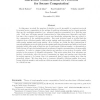130 search results - page 9 / 26 » How to Encrypt with a Malicious Random Number Generator |
IJNSEC
2011
13 years 2 months ago
2011
We introduce some modifications to the widely deployed Kerberos authentication protocol. The principle’s secretkey will be independent of the user password to overcome the weak...
SIAMCOMP
2011
13 years 2 months ago
2011
In this paper, we study the question of whether or not it is possible to construct protocols for general secure computation in the setting of malicious adversaries and no honest m...
ASIACRYPT
2003
Springer
14 years 24 days ago
2003
Springer
Abstract. We study two closely related primitives: Broadcast Encryption and Key Predistribution Schemes (KPS). Broadcast Encryption allows a broadcaster to broadcast an encrypted m...
STOC
1993
ACM
13 years 11 months ago
1993
ACM
We analyze algorithms that predict a binary value by combining the predictions of several prediction strategies, called experts. Our analysis is for worst-case situations, i.e., we...
PKDD
2009
Springer
14 years 2 months ago
2009
Springer
We propose a new, recursive model to generate realistic graphs, evolving over time. Our model has the following properties: it is (a) flexible, capable of generating the cross pro...

